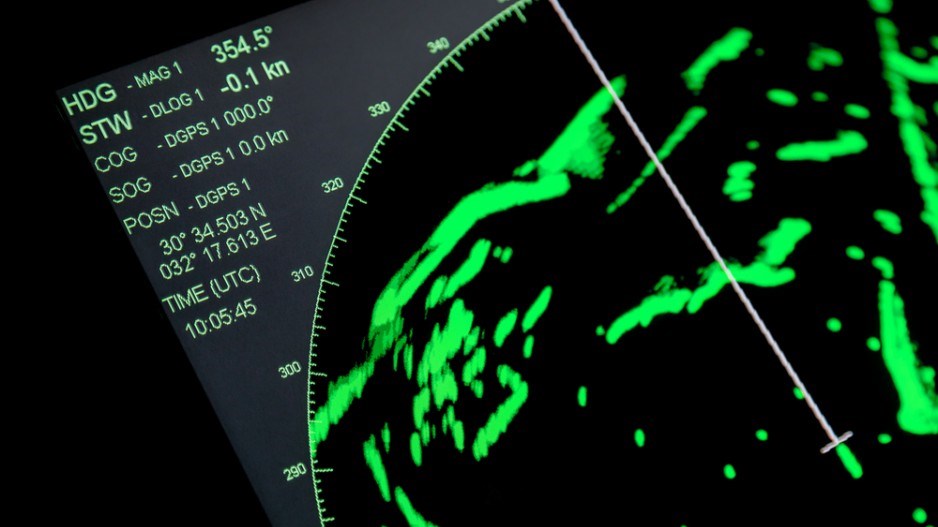In the wake of the English Bay crude oil spill, more concerns are being raised over compromised Port Metro Vancouver ship traffic control and safety as the closure of the Vancouver Marine Communications and Traffic Services (MCTS) centre looms.
The Coal Harbour marine communications hub monitors the movements of all vessels over 20 metres (66 feet) in the port from the 23rd floor of 555 West Hastings Street. On May 6, it’s scheduled to be moved to Victoria, where Vancouver harbour traffic will be monitored via radar, transponders and cameras. B.C.’s other remaining marine traffic-monitoring centre will be in Prince Rupert. The move is part of a federal government plan to consolidate the country’s 22 marine communications centres into 12. Ottawa has maintained that the budget-cutting initiative’s updated communications technology will streamline MCTS operations and make better use of its reduced complement of Canadian Coast Guard personnel. But Allan Hughes, western regional director for Unifor Local 2182, said the loss of visual perspective from the Vancouver harbour centre will seriously impair the hub staff’s ability to monitor ship traffic in Canada’s busiest port. Without its harbour-side visual reference, Hughes said the effectiveness of the new system will be “a crapshoot.” “The area is not covered well by radar. That’s why the centre is located where it is. They need to have that visual reference to prevent collisions and accidents.” The federal government’s MCTS consolidation began in April 2013 to cut costs and modernize its marine communications and traffic services via a $64 million program to outfit all the stations with the same communications technology. It will result in the closure of MCTS centres in Vancouver, Tofino and Comox. Gregory Lick, director general of operations for the Canadian Coast Guard, said the $53.4 million invested in the system’s updated communication control system “allows us to provide the main communication traffic system from almost anywhere. [So] whether the choice was Victoria or Vancouver, it doesn’t make a difference in services provided in Vancouver.” He said the decision to consolidate the centre in Victoria rather than in Canada’s busiest port “was a choice of strategic locations to best serve the marine community and achieve the desired efficiencies.” Lick said the MCTS consolidation program will result in annual department savings of approximately $5.4 million. He added that concerns over the loss of visual contact with Vancouver harbour vessels are largely groundless because none of the MCTS centres across the country rely on visual contact. “Because if you tried to rely on that in a country where you have fog, you have rain, you have blizzards, it would be very unreliable.” But Hughes said the new technology has “failed miserably in the centres in which they rolled it out; the western Arctic in 2013 was without reliable communication for most of the navigation season because of it.” He added that the automated system designed to record weather on the Continuous Marine Broadcast is not fully functional. Hughes pointed out that, in Vancouver, taller buildings in the city’s core have eroded radar coverage in the harbour. “The area that the coast guard can see via radar is diminishing.” He said that assisting incoming freighters in securing anchorages while they wait to dock in Port Metro Vancouver will be another coast guard service that will be severely curtailed. However, Frank Stanek, manager of media relations for Fisheries and Oceans Canada (DFO), said the modernized MCTS centres will improve their operational effectiveness. “Coverage will remain exactly as it is today because the network of radio and radar towers across Canada will not change.” He added that the Canadian Coast Guard has completed rigorous testing of the new communications technology “and has confirmed the systems are fully functional and ready for installation to modernize MCTS centres.” Port Metro Vancouver spokesman John Parker-Jervis said the port has been in ongoing discussions with the coast guard about the Vancouver MCTS centre’s closure and thus far has no concerns about compromised ship traffic safety. “The Canadian Coast Guard has assured us there will be no reduction of services and that core mandate vessel traffic services to mariners will not be affected.” There are approximately 42,000 vessel traffic movements, including ship departures, arrivals and anchorages, in the Vancouver area annually. Hughes said that with more than half a million vessel movements annually along B.C.’s coast the consolidation of marine traffic oversight will be felt up and down the coast. “Recognizing that they don’t have enough staff in place to effectively monitor the coast, [the coast guard] have reduced the traffic services zone in Prince Rupert/Tofino from 70 miles offshore to 12, and they’re slowly reducing the number of people there to handle emergencies and make sure commercial traffic gets safely to where it’s bound.” |
Prior to the consolidation of B.C.’s five MCTS centres into two, there were 118 MCTS staff across B.C. According to DFO, once the consolidation program has been fully instituted, there will be 82. Overall, MCTS staffing will be reduced to 242 positions from 337 by the time the consolidation process is completed in spring 2016.




